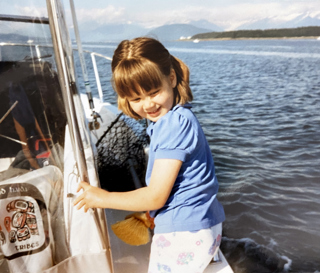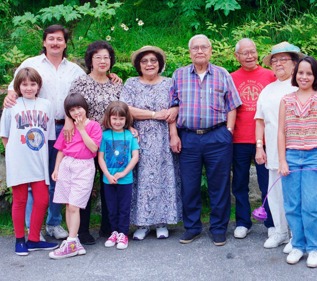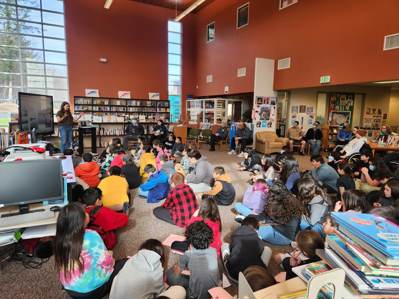
Tlingit Artist Michaela Goade Storytelling and the Art of Being Human
February 28, 2024
By Francesca Dubrock, Chief Curator
Tlingit and Norwegian artist Michaela Goade grew up in Juneau, Alaska in a creative family that nurtured her artistic and musical interests. Early memories are informed by being surrounded by water and trips “traveling the ocean, waterways, camping, fishing, playing on beaches…occasionally being terrified and also having magical encounters with weather and water.” 

Top: Goade on the water, 1994.
Bottom: Goade (in blue) with her
family in Juneau, 1994.As she grew, Goade sought ways to mobilize her creative talents through worldbuilding and storytelling, which led to a career in graphic design in Anchorage. Partnering with local Alaska organizations and brands that shared her place-based ethos, she honed her skills as a visual storyteller. Eventually, Goade returned home to Southeast Alaska, where she began the first of several collaborations with Sealaska Heritage Institute (SHI), illustrating Lingít language storybooks.
Goade reflects that her creative career has “mirrored a journey towards cultural reconnection and figuring out not only who I am as an artist, but as a Tlingit artist and a multiracial Tlingit artist.” Growing up, she says, her identity as a Native person wasn’t affirmed by her peers or in the public school system. Family connections to culture also diminished as relatives and elders moved out of state or passed away. The process of working with SHI to create stories through the Baby Raven Reads program has gifted Goade with opportunities to connect on many levels—through Lingít language, story, and collaboration with other Tlingit cultural practitioners. Salmon Boy: Shanyáak'utlaax, which was adapted from a traditional Lingít story, was named the 2018 American Indian Youth Literature Best Picture Book. Goade has gone on to illustrate many books with authors across the country, including the 2021 Caldecott award-winning We Are Water Protectors, by Carole Lindstrom, and Remember, written by Joy Harjo and published in 2023. She took on writing and illustration for her book Berry Song, a touching meditation on connection to land, harvest, and intergenerational knowledge, which was published in 2022.
Hearing positive feedback from teachers and young people—especially Native students—is a huge motivator for Goade. She wants younger folks to understand, “hey, you could do this too. Your stories are important. Your art is important. Representation is everything.”
 A selection of books Goade illustrated or wrote between 2018 and 2024.
A selection of books Goade illustrated or wrote between 2018 and 2024.
She is excited to see so many up-and-coming Native writers and illustrators in the industry, as well as increasing Native representation in Hollywood and on television. She’s also driven to continue her own language learning journey by incorporating Lingít words into her projects. “I love to learn, and being curious is an important part of this work. I get to incorporate language learning, explore cultural values, traditions, and stories, and try my best to honor our people through the stories I tell. Additionally, I get to introduce these concepts to readers young and hold, many of whom reside outside the state.” These books, she says, are for Native and non-Native children alike, and that all children benefit from honest and truthful representations that affirms many different identities.

Left: Goade working on Berry Song, 2021. Photo by Bethany Goodrich. Right: Goade berrypicking, 2021.
To create her work, Goade draws on childhood experiences of the natural world and taps into “what it was like to be a kid, when the world felt open for adventure and curiosity and magic. But it’s also important to remember the flip side—there can also be a lot of anxiety, fear, and big, new, emotions to navigate.” Reconnecting with that little kid part of herself has, fortunately, never been difficult for Goade, who was always considered a dreamy, head-in-the-clouds type by her friends and family. However, the process of bringing her visions to life in physical form is arduous, with each book taking over a year to complete. She works as much as she can by hand, using watercolor, colored pencil, and pastel. She scans finished artworks in six to eight sections, which she stitches together in large Photoshop files. She then fixes mistakes, adds details, or enhances elements digitally until the work is ready for print.
Goade at the Lummi Nation school library
with students, 2023.
In addition to improving Native representation in picture books, Goade hopes her work “helps people feel a love and appreciation and gratitude for place…that might manifest into all sorts of actions.” Acknowledging that people won’t change their destructive relationship with the environment unless they begin to care, Goade hopes her books “help people see the land in a different light and encourage readers to think about their own connections to land and community, and how they might deepen those relationships.” Goade says that we can all recall certain books that made an impression on us as children, books that “for whatever reason we latched onto, and that on some deep level become part of us. We may not even remember the title or the author…we just remember the book and how it made us feel.” Knowing that the books she writes and illustrates today might be remembered by people 20, 30, 50 years in the future is one of the best parts of her work. And she’s quick to add: “Picture books are for all ages. Storytelling is at the heart of being human.”